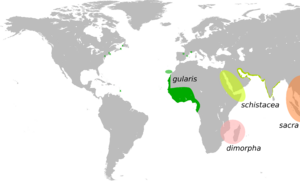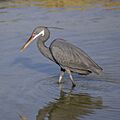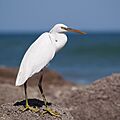Western reef heron facts for kids
Quick facts for kids Western reef heron |
|
|---|---|
 |
|
| E. g. schistacea dark morph
Dohat Arad Lagoon, Muharraq, Bahrain |
|
| Conservation status | |
| Scientific classification | |
| Genus: |
Egretta
|
| Species: |
gularis
|
 |
|
| Range with subspecies and related species. For dimorpha, see dimorphic egret | |
The western reef heron (Egretta gularis), also known as the western reef egret, is a medium-sized heron. You can find it along the coasts of southern Europe, Africa, and parts of Asia. This bird comes in different colors. Some are a dark grey, which might look a bit like a rare dark Little egret (Egretta garzetta). Others are white, similar to the little egret, but they usually have a paler, larger beak. There's also a black form with a white throat found in West Africa.
Scientists have sometimes wondered if the western reef heron mixes with the little egret. Because of this, some people think certain types of reef herons are just subspecies of the little egret. However, many experts consider the western reef heron a unique species with its own different types.
Contents
What Does the Western Reef Heron Look Like?
This bird comes in two main color forms, called morphs. There's an all-white morph and a dark grey morph. You might also see birds with shades of grey in between, or even grey and white patches. These differences can sometimes depend on the bird's age.
White and Grey Morphs
The white morph looks a lot like the little egret. However, the western reef heron usually has a bigger, yellower beak and thicker, more yellow legs. When it hunts for food, it's very active. It might even move its wings or use them to create shade on the water.
The grey morph has a white throat. This makes it easy to tell apart from other egrets in its home range. Its beak and legs are similar to the white morph.
Special Features for Breeding
During the breeding season, the legs and the skin around the bird's face turn reddish. Breeding birds also grow two long feathers on the sides of their neck.
There are different types of western reef herons depending on where they live. The gularis type lives from West Africa to Gabon, and some even breed in southern Europe. The schistacea type breeds from the Persian Gulf all the way along the coast of India. The gularis type has a more pointed beak, while schistacea has a larger beak, especially near its base. Another type, found on the eastern coast of South Africa, is usually called the dimorphic egret (Egretta dimorpha).
Scientists believe that the dark and white colors are controlled by a single gene. The dark color seems to be partly stronger than the gene for white.
How Scientists Study and Name Birds
The western reef heron was first described in 1792 by a French scientist named Louis Augustin Guillaume Bosc. He called it Ardea gularis. The name gularis comes from the Latin word for throat, because the dark morph has a clear white throat.
Over time, scientists have changed the heron's scientific name several times before settling on Egretta gularis. There has been a lot of discussion about whether this bird is truly a separate species from the Egretta garzetta, or little egret. Some scientists even thought the little egret might have dark forms, but most of these turned out to be western reef herons.
Understanding Bird Relationships
In India, some studies suggested that western reef herons and little egrets might breed together. However, the same researchers also noted that their breeding seasons were different. Scientists use many clues to understand bird relationships, including how they look and their DNA. DNA studies have helped scientists learn more about how these birds are related.
For example, the skin around the eyes (called the lores) of breeding little egrets are blue, while those of the reef heron are reddish. However, some schistacea types show blue lores, which might suggest some mixing has happened in the past.
A dark coastal type of egret found in places like Madagascar and parts of East Africa was once thought to be a subspecies of the western reef heron. But now, it's considered its own full species, called the dimorphic egret (Egretta dimorpha).
Where Do Western Reef Herons Live?
Western reef herons mainly live along the coasts in warm areas. You can find them in tropical West Africa, around the Red Sea, in the Persian Gulf (like Iran), and stretching east to India. They also live on the Lakshadweep Islands and in Sri Lanka.
The gularis type breeds in West Africa, from Mauritania to Gabon. You might also see them on islands off the mainland, like the Canary Islands. A small number even breed in Spain.
The schistacea type is found from the Red Sea coast eastwards around the Indian coast. They have breeding colonies on the east coast of India, for example, near Pulicat Lake. Sometimes, they can be found a bit further inland, away from the coast.
Traveling Birds
The western reef heron (the gularis type) sometimes travels far from its usual home. It has been seen as a rare visitor in North America, South America, and the Caribbean islands. With more and more sightings, some people think they might even start breeding in Brazil.
Western Reef Heron Behavior and Life Cycle
These birds are clever hunters in shallow water. They often run or stir the water with their feet to scare out prey. They might also flick their wings to disturb fish. Sometimes, they stand very still and wait to surprise their food.
What Do They Eat?
Western reef herons eat fish, crustaceans (like crabs), and molluscs (like snails). In coastal areas, they often eat mudskippers, which are fish that can live on land. Studies show they are good at correcting for how light bends in water when they strike at prey.
Like other herons and egrets, they don't make many sounds. They might make a low kwok sound or grating noises if they are disturbed or near their nest.
Reproduction and Nesting Habits
The western reef heron's breeding home is in coastal wetlands. In the Red Sea area, they breed from June to August. In West Africa, the gularis type breeds from late April to September. In India, they breed during the monsoon rains, from April to August.
They build their nests in colonies, usually with other western reef herons. Sometimes, they share colonies with other egrets and smaller herons. Their nests are platforms made of sticks, placed in trees or shrubs. The male bird brings sticks, and the female arranges them to build the nest. Nests can be from about 5 to 15 meters high, but sometimes they nest very low, especially in mangrove trees in salt pans.
The female usually lays three to four eggs. The eggs are light blue, just like those of the little egret. Incubation starts when the first egg is laid. This means the chicks hatch at different times, so some are bigger than others. Both parents take turns sitting on the eggs, which hatch after about 23 to 24 days.
Raising the Chicks
The chicks are white with grey spots. Sometimes, young birds fall from the nest platform and don't survive. Adult birds will shade their chicks during the hottest parts of the day.
Rats might eat the eggs, and young chicks can be taken by cats and crows. Adult herons usually guard the nest when there are eggs or young chicks. The parents feed their young by bringing back partially digested food. This food is mostly small fish. The young birds leave the nest after about a month.
Images for kids
-
Dark morph, Bahrain
-
Slate grey morph, Bahrain
-
White morph, Muscat
-
particoloured form (Egypt)
-
E. g. gularis dark morph in flight, showing white carpal area, São Tomé and Príncipe











